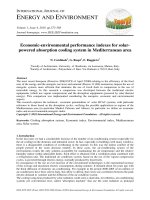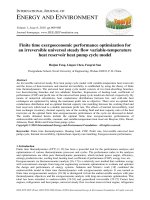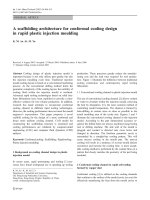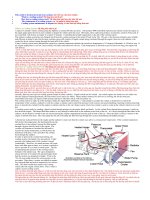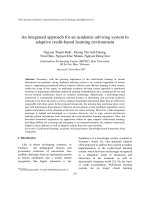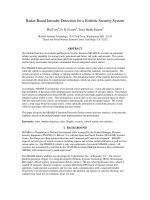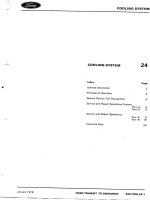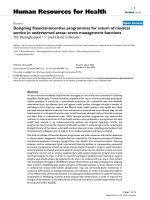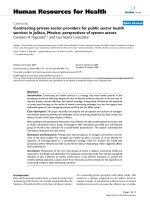Economic-environmental performance indexes for solarpowered absorption cooling system in Mediterranean area
Bạn đang xem bản rút gọn của tài liệu. Xem và tải ngay bản đầy đủ của tài liệu tại đây (1.03 MB, 16 trang )
INTERNATIONAL JOURNAL OF
ENERGY AND ENVIRONMENT
Volume 1, Issue 4, 2010 pp.573-588
Journal homepage: www.IJEE.IEEFoundation.org
Economic-environmental performance indexes for solarpowered absorption cooling system in Mediterranean area
N. Cardinale1, G. Rospi1, F. Ruggiero2
1
2
Faculty of Architecture, University of Basilicata, via Lazzazera, Matera, Italy.
Faculty of Architecture , Polytechnic of Bari, Via Orabona 4, 70123, Bari, Italy.
Abstract
The most recent European (Directive 2006/32/CE of April 5/2006 relating to the efficiency of the final
uses of the energy and the energetic services) and national (Decree 311/06) normatives impose the use of
energetic systems more efficient that minimize the use of fossil fuels in comparison to the use of
renewable energy. In this research a comparison was developed between the traditional electric
equipments (which use vapour compression) and the absorption equipments (powered by solar thermal
energy). This comparison was implemented considering the energetic, economic and environmental
aspects.
This research explores the technical - economic potentialities of solar HVAC systems, with particular
reference to those based on the absorption cycles, verifying the possible applications in regions of the
Mediterranean area (in particular Madrid, Palermo and Athens). In particular we define an economic
index and an environmental-energetic index.
Copyright © 2010 International Energy and Environment Foundation - All rights reserved.
Keywords: Cooling absorption system, Economic index, Environmental index, Mediterranean
area, Solar system.
1. Introduction
In the last years we had a considerable increase of the number of air-conditioning system (especially for
the air cooling) in the domestic and industrial sector. In fact, especially in buildings with many windows,
there is a disagreeable condition of overheating in the summer. In this way the indoor comfort of the
people present in the room decrease notably. In these cases, the air-conditioning system of the
environments results the only solution acceptable for maintaining the air temperature and the relative
humidity indoor within admissible limits. Such effect is obtained with a ventilation plant combined with
a refrigeration unit. The traditional air conditions system, based on the use of the vapour compression
cycles, is powered through electric energy, normally produced by fossil fuels.
In consequence of the use an ever-increase of the conventional technologies is the exponential increase
of the average and maximum electric consumptions during summer. It initiated about ten years ago with
the thick diffusion of domestic air-conditioning. For example in the period 2000-2005 seven million of
air-conditioners have been sold in Italy, this allow to affirm, that exists one correlation between the peak
electric demand in summer and the diffusion of the air-condition system.
The cooling using heat produced by solar radiation could seem a mad idea; nevertheless, air-conditioning
systems not conventional exist, called "absorption machine” that use the solar radiation as principal
ISSN 2076-2895 (Print), ISSN 2076-2909 (Online) ©2010 International Energy & Environment Foundation. All rights reserved.
574
International Journal of Energy and Environment (IJEE), Volume 1, Issue 4, 2010, pp.573-588
energy source for developing a process for cooling the room. In fact, the absorption systems differ from
the traditional mechanical refrigerator because they use a "thermal compressor" rather than “mechanical
compressor”. A description of the principles of absorption system is defined in [1] and [2]. The papers
dealing with the solar absorption system can be divided in three categories. In the first group we have
different simulation models applied to distinct typologies of absorption system [3], [4], [5], [6] and [7].
The second group includes experimental researches [8] and [9]. In the last group economic-viability
analysis have been carried out [10] and [11]. In this paper a technical economic comparison will be
developed among traditional air-conditioning systems and integrated absorption systems powered by
solar thermal energy for different Mediterranean places. In particular we define an economic index and
an environmental-energetic index. The software SolAC (Solar Air Conditioning, IEA-Task 25) was used
to identify the optimum solution among the different solar absorption system studied [12] and [13].
2. Plant configurations and performance parameters
In this research was determined the energetic-economic performances of air-conditioning systems
powered by solar energy and to compare with the energetic-economic performance of conventional
compression system. The result was realized by the study of different plant configurations and changing
some parameters: the site of system installation, the solar collector type, the cost of the components, the
surface of the solar field, the volume of thermal storage etc..
The plant of reference, whose scheme is in Figure 1, is characterized by the parameters reassumed in
tables 1 and 2, relative to technological and economic aspects. They are often described in terms of
specific costs, for example, cost for kW of installed power or for m2 of collector etc.
Figure 1. Absorption system scheme with electric backup
Solar collector employed are: FPC, the plate collectors with selective surface, CPC, the static parabolic
collectors, and ETC, the evacuated tubes collectors without concentrator.
The specific cost, in this research, is only referred to the equipment, in particular its refers to kW
installed of cooling so it doesn't include the costs of plant installation.
The values shown in the preceding table are identical for all the solar systems, which ever is the solar
thermal collector used. In the case of the conventional system was considered, only the secondary pump
of the refrigeration circuit.
ISSN 2076-2895 (Print), ISSN 2076-2909 (Online) ©2010 International Energy & Environment Foundation. All rights reserved.
International Journal of Energy and Environment (IJEE), Volume 1, Issue 4, 2010, pp.573-588
575
Table 1. Parameters, characteristics and cost of the system analysed [14]
Component characteristics
Solar collector
FPC
CPC
ETC
Optic efficiency, c0
0.789 0.94
0.86
Coeff. linear loss,
2.88
2.20
2.02
c1 (Wm-2K-1)
Coeff. quadratic loss, c2 0.0180 0.0330 0.0022
(Wm-2K-1)
Longitudinal IAM
0.92
0.9
0.9
(50° incidence)
Transversal IAM
0.92
0.8
0.9
(50° incidence)
System air-condition
Absorption Electric to
to single
compression
effect
Specific cost
400 €/kW 310 €/kW
Component cost
Solar collector
FPC
CPC
ETC
280 €/m2
400 €/m2
620 €/m2
primary Pump solar circuit (nominal
400 €
electric power 0.002 kW/m2 cool)
secondary Pump solar circuit (nominal 250 €
electric power 0.002 kW/m2 cool)
Thermal storage (loss coeff. 0.8 w/mK 600 €/m3
Primary Pump refrigeration circuit
(Nominal electric power 0.3 kW)
550 €
secondary Pump refrigeration circuit
(Nominal electric power 0.3 kW)
550 €
Table 2. Financial and use energy parameters
Investment cost
Hydraulic systems installation
of compressor system
Hydraulic systems installation
of solar-thermal system
Hydraulic systems installation
of traditional backup
Value
20000 €
Management costs
Electricity cost - energy
Value
0.1044 €/kWh
15000 €
electricity cost - installed power
(peak loads)
Annual maintenance costs of
thermal solar system
Annual maintenance costs of
other components
75 €/kW
0.36 kWhel/
WhEP
0.8 kg/kWhel
5000 €
Financial parameters
Plant operative Life
20 years
Electric production Efficiency
Rate of interest
6%
CO2 Specific emissions from
power
10 % inv. cost
20 % inv. cost
The parameters of performance evaluated, for the different plant configurations and the different site, are:
- The primary energy saving, EPsav, defined as the difference between the annual consumption of
primary energy of the compression system and that of the solar system. In the results, this value, is cited
in percentages terms in comparison to the conventional system, that is:
EPsav =
EPcons ,ref − EPcons , sol
EPcons ,ref
(1)
Since we have considered only the cases with a primary energy consumption superior to that of the
traditional system of reference, the parameter so defined always results positive.
- The net annual efficiency of the collectors, equal to the ratio between the useful thermal energy
produced by the solar field within the year and the incident radiation on the collectors in the same timeframe.
- The cost of the saved electric energy through the employment of the absorption plant powered
by solar energy is defined as:
ISSN 2076-2895 (Print), ISSN 2076-2909 (Online) ©2010 International Energy & Environment Foundation. All rights reserved.
576
Cel , sav =
International Journal of Energy and Environment (IJEE), Volume 1, Issue 4, 2010, pp.573-588
Cann , sol − Cann , ref
Eel , sav
(2)
where, Cann,sol represents the annual cost of the solar plant elioassistito, Cann,ref that of the compression
system of reference, and Eel,sav is the electric energy saved in one year [kWh]. From the comparison of
this parameter with the market price of the electric energy, it is possible to obtain the saving energy in
kWhel.
- The percentage annual cost of the absorption system in comparison to the compression system:
Cann , sol
Cann ,ref
⋅100
(3)
The percentage first cost (of investment) of the solar system in comparison to the same cost related to the
traditional system:
CInv , sol
⋅100
CInv ,ref
(4)
For every analysed configuration, the parameters defined before, were calculated in function of the solar
collectors surface of the solar field and the heat storage of the same solar system. Particularly, the area of
collectors was varied as percentage fraction of the building surface from air-condition. This percentage
varied from a 10% minimum (0.1 m2 of collector surface over m2 of building surface) to a maximum of
100% (1 m2 of collector surface over m2 of building surface). While, the solar thermal storage can be
express both as number of hours in which the solar system results able to autonomously feed the
absorption cycle in absence of incidental radiation on the collectors, that in terms of meters cubes of
storage required for the same purpose. The presence of certain heat storage avoids that the auxiliary
electric system begins to work when the incidental radiation results insufficient to sustain the absorption
process. It also allows getting a great saving of primary energy and a more efficient employment of the
whole solar system.
The storage heater capacity, express in times, can be defined as:
CA = m fl ⋅ c p , fl
Tacc ,m − Tch
Pch ⋅ 3600
⋅ COPch
(5)
In this formula: mfl is the stored fluid mass [kg], Tacc,m is the maximum temperature in the tank [°C], Tch
is the operative temperature of the absorption cycle [°C], Pch is the nominal power of the absorption
system [kW], and the COPch is the coefficient of performance of the absorption cycle.
In the paragraphs that follow are describe the results some systems characterized optimal ideal, for every
of select district of the Mediterranean area. The result was obtain in proportion to restriction imposed
above solar field efficiency value and on the real primary energy saving. Particularly we considered
competitive those configurations, that, have shown an annual net efficiency superior to 20% (this for not
to penalize too much the expensive solar technology) and, contemporarily, have allowed an primary
energy saving superior to 25% in comparison to demands of the conventional plant. Finally, among all
the cases that respected limits, we choose, for every collector typology and for every district, that with
the least cost of the saved electric energy.
3. Summer thermal load of the districts considered
All the evaluations were carried using meteorological hour data of three Mediterranean places: Palermo,
Madrid and Athens. They were held representative of typical climatic conditions of this area relating to
summer air-conditioning. The following table reports a description a of the climatic regime for these
three cities.
ISSN 2076-2895 (Print), ISSN 2076-2909 (Online) ©2010 International Energy & Environment Foundation. All rights reserved.
International Journal of Energy and Environment (IJEE), Volume 1, Issue 4, 2010, pp.573-588
577
Table 3. Climatic trend of the three Mediterranean places
City
Lat.
Horizontal
global radiation
Palermo 38.1°
1690
kWh/m2year
Madrid
40.4°
1664
kWh/m2year
Athens
39.0°
1566
kWh/m2year
Global radiation Climatic trend
on the collectors
plan
1879
Maritime climate, with elevated humidity and
kWh/m2year
high summer temperatures. Typical season for
the conditioning is from April to October.
1711
Continental Mediterranean climate with high
kWh/m2year
temperatures but moderated humidity in the
summer.
1710
Mediterranean maritime climate with elevated
kWh/m2year
summer temperatures. Typical season for the
conditioning is from April to October.
We presumed to orient the collectors to South with an inclination of 30° relating to the horizontal plan in
oder to maximize the useful solar energy. The meteorological data, represented by hour temporal series,
were produced by the Meteonorm [14] software, this have allowed to calculate the radiation on the
collectors plan (30° of inclination).
Athens present the great summer temperatures. The highest humidity and the greatest solar radiation are
found in Palermo.
Figure 2. Building plan of the analyse building
The selected building is composed by three floors, with a surface of 643 m2 all to be conditioned, equal
to the area of one level (Figure 2). It is oriented along the direction Nord-Sud and present, on every floor,
a central corridor. The windows surfaces on North and South fronts are the 25% of the total to the front.
The windows surface on East and West is the 4%. The destination usage is Hotel. This buildings are
realized in reinforced concrete with a good thermal isolation that minimize the thermal losses in winter
and the thermal gains in summer.
The envelope thermal characteristics are: the walls thermal transmittance 0.45 W/m2K and the windows
thermal transmittance 1.8 W/m2Ks. The summer thermal load considered are essentially characterize by
solar gains and by internal load (Figure 3).
The software SolAC (Solar Air Conditioning, IEA-Task 25) allowed, for every of the select places, a
comparison among different system configuration. This, have permitted of individuation the optimal
configuration in regard to the energetic and economic limits.
In the follow paragraphs are described the result of the energetic and economic performances of the three
places. Contextually to be analysed a series of hypothesis finalized to the reduction of the annual cost of
the solar air-conditioning, purposive to increase the competitiveness of this system towards the
conventional technologies.
ISSN 2076-2895 (Print), ISSN 2076-2909 (Online) ©2010 International Energy & Environment Foundation. All rights reserved.
578
International Journal of Energy and Environment (IJEE), Volume 1, Issue 4, 2010, pp.573-588
Figure 3. Summer thermal load of the tree studied places
4. Methodology of evaluation of energetic-economic performances
We consider as example the case of the Palermo city. The annual energetic requirements for air-condition
an m2 of building results equal to around 196 kWh/m2. This correspondent at the most value among the
analysed places.
Figure 4. Solar factor and collectors net efficiency against the solar field surface
In the Figure 4 is represented the solar factor and collector net efficiency against the solar surfacebuilding surface ratio. The ratio value equal to 0,1 and 0,2 represent a good compromise.
Figures 5 and 6 illustrate the value of the useful energy produced (expressed in hours) by the solar field
and of the solar factor in connection with the employed collector types and the heat storage system. As is
obvious, the result obtained are increase of the some solar system performances and increase the
annually useful thermal energy produced by 1 m2 of active surface. Between the solar factor and the
efficiency (in correspondence of an increase of the first parameter correspond a reduction of the useful
energy produced for effect of the net efficiency diminution) exists a inverse proportionality relationship.
ISSN 2076-2895 (Print), ISSN 2076-2909 (Online) ©2010 International Energy & Environment Foundation. All rights reserved.
International Journal of Energy and Environment (IJEE), Volume 1, Issue 4, 2010, pp.573-588
579
Figure 5. Useful annual energy produced by one m2 of collector against thermal storage typology system
Figure 6. Solar factor against the collector type and the thermal storage capacity of the system
Using the flat collectors is necessary an active area double in comparison to evacuated collectors area.
(0.2 and 0,1 m2/ m2 of building surface - collector surface ratio).
The table 4 synthesize the results related to the three configurations consider optimal respect to the
imposed limits on the collector efficiency (> 20%) and on the primary energy saving in comparison to
the traditional configuration (> 25%).
Despite an investment to around 86 k€ for the typology FPC, in the case of the ETC the investment is 88
k€ for have the half active surface. Only thanks to the efficiency of the evacuated collector (ETC), saved
annual energy is similar (45.5% against the 51.47 %). Then, further advantage of the systems realized on
evacuated collector is represented by a smaller surface for the solar field installation. This possibility is
ISSN 2076-2895 (Print), ISSN 2076-2909 (Online) ©2010 International Energy & Environment Foundation. All rights reserved.
580
International Journal of Energy and Environment (IJEE), Volume 1, Issue 4, 2010, pp.573-588
always pleasant, because in the greatest part of the existing buildings, doesn’t exist a special area to the
possible installation of solar system.
Table 4. Parameters results of the optimal configuration
Collector
type
FPC - (0.2)
CPC - (0.1)
ETC - (0.1)
Surface
collectors ratio
installed kW
4.80 m2/kW
3.48
2.71
heat
storage
volume
5.98 m3
4.09
4.14
Net
Annual cost
efficiency respect
traditional case
29.02 %
124.70 %
40.11
121.46
52.0
130.80
electric saved
energy respect
traditional case
51.47 %
35.52
45.50
Electric saved
energy Cost
0.139 €/kWh
0.175 €/kWh
0.196 €/kWh
The Figures 7 and 8 illustrate the trend of the cost and efficiency against the saved primary energy
(always in the case of flat collectors).
The minimum point is represented in both the Figures and it indicates a good energetic-economic
combination for the optimal FPC configuration. We have increase of the saved electricity energy cost
with a increasing the investment cost. In correspondence of least cost, the efficiency becomes constant
(Figure 8).
Figure 7. Collectors surface: 0,2m2 and collector type FPC
The annual present rate of the investment cost was calculated, for each of the examined configurations,
using the typical formula of the present coefficient:
n
i ⋅ ⎡(1 + i ) ⎤
⎣
⎦
Fa =
n
⎡(1 + i ) − 1⎤
⎣
⎦
(6)
in which, is the rate of interest (fixed to 6%) and n is the service life of the solar system (fixed to 20
years). Multiplying Fa by the general investment, the annual present rate of the investment cost Cinv,ann is
obtained. Adding to the annual management and maintenance costs, Co&m, furnishes the already defined
annual plant cost of the system: Cann,ref, for the traditional case and Cann,sol for the different solar
absorption configurations.
ISSN 2076-2895 (Print), ISSN 2076-2909 (Online) ©2010 International Energy & Environment Foundation. All rights reserved.
International Journal of Energy and Environment (IJEE), Volume 1, Issue 4, 2010, pp.573-588
581
Figure 8. Collectors surface: 0,2 m2 and collector type - FPC
The table 5 synthesizes the economic results of the optimal configurations for each specific solar
technology. The employment of a vapour compression cycle (traditional case power 50 kW) implies an
annual consumption of electricity energy equal to 42210,81 kWh , corresponding to an emission of
33768,65 CO2kg.
A technological change toward solar system involves an increase of the total annual cost; this is obtained
essentially because of the greatest investment in equipments. Contrarily, the management costs show a
drop, in comparison to the traditional system. This is connected to the smaller annual electric
consumption of the solar absorption system. In fact, in this last case, only the electric backup system gets
energy by the electric net, in case of necessity
Table 5. Economic and emission related to optimal configurations [A = specific area]
Plant Type (To)
Traditional
FPC - (0.2)
CPC - (0.1)
ETC - (0.1)
Cinv, ann
3197.06 €
7514.49 €
6300.10 €
7674.24 €
Co&m
9040.21 €
7743.60 €
8563.25 €
8331.76 €
Cann
12237.27 €
15258.08 €
14863.35 €
16006.00 €
Saved electric energy
21724.83 kWhel
14992.62 kWhel
19204.27 kWhel
Avoided CO2 emission
17379.86 Kg
11994.09 Kg
15363.41 Kg
In Figure 9 the horizontal continuous line delineate the reference condition (100% of the annual cost
corresponding to the traditional system). The black circle corresponds to the solar configuration (FPC,
Palermo); with an annual cost equal to 124.7% (ordinate) and a total investment cost of 235% (abscissa)
in comparison to the reference condition. The point indicated by the triangle represents the condition for
which the cost of the saved electric in kWh succeeds to equalize the electricity market price (0,104 € /
kWh). This price, thanks to the employment of the solar energy changes from 0,139 € to 0,104 €. For
obtain this price is necessary to reduce the investment costs of 211,5%, and annual cost 118,5%.
Moreover, we consider an incentive for any avoided CO2 emission. This incentive is very important to
amortize the cost of a plant. For example, we consider an incentive of 45 €/ton avoided CO2 emission to
amortize the FPC collector system, an incentive of 85 €/ton avoided CO2 emission to amortize CPC
collector system and an incentive of 115 €/ton avoided CO2 emission to amortize ETC collector system.
In these last two cases, besides the importance of the smaller avoided CO2 quantity because of the
reduction of the employed active surface, the superior cost of technological investment plays a
fundamental role.
ISSN 2076-2895 (Print), ISSN 2076-2909 (Online) ©2010 International Energy & Environment Foundation. All rights reserved.
582
International Journal of Energy and Environment (IJEE), Volume 1, Issue 4, 2010, pp.573-588
Figure 9. Annual cost and investment cost [FPC]
Simultaneously we consider the effect of the electricity price increment. Particularly, was considered
increase of the electric energy market price from a reference of 0,14 €/kWh up to the value of 0.21
€/kWh (200%). Moreover, we have an increase of electric equipments management costs from a
reference of 75 €/kW installed to 150 €/kW installed. This hypothesis considers the peak electric
consumptions in summer air-conditioning.
From the Figure 10 we observed that, in the FPC-150 case, we archive the break-even point in
correspondence of an increase of the electricity price around 40%.
Figure 10. Effect of the electricity price increase and electric equipments management cost [FPC]
The considerations describe in the preceding paragraphs for the Palermo city, are repeated identically for
the other two studied cities. Obviously, only differences are in the numerical results, because of the
different environmental conditions and of the different energetic demand of air-conditioning
ISSN 2076-2895 (Print), ISSN 2076-2909 (Online) ©2010 International Energy & Environment Foundation. All rights reserved.
International Journal of Energy and Environment (IJEE), Volume 1, Issue 4, 2010, pp.573-588
583
5. Economic-environmental performances indexes for Palermo, Madrid and Athens
These indexes consider, either the investment and exercise costs of the absorption system, also the
environmental performances in comparison to the traditional system. First of all, the Figure 11 and
Figure 12 show a general vision of the results for the different site and solar technologies, in terms of the
installation system costs and electricity saved costs with the absorption system.
Figure 11. Total cost of the system relative at kWh saved
Figure 12. Total cost of the system relative at kWh saved
ISSN 2076-2895 (Print), ISSN 2076-2909 (Online) ©2010 International Energy & Environment Foundation. All rights reserved.
International Journal of Energy and Environment (IJEE), Volume 1, Issue 4, 2010, pp.573-588
584
Exclusively considering this last parameters, the solution Pa-FPC (Palermo, flat collectors) would seem
the best (Figure 12). Instead, if you observe in the Figure 12, the solution Pa-FCP is characterized by the
highest investment cost, even though, it uses a low cost technology and little efficient, as the solar flat
collectors.
In the end was assess the annual electric kWh saved from each solar configuration (this are strictly linked
at the annual quantity of CO2 saved and not blow in environment). For all solar configurations, was
defined the next performance index:
-
Economic performance index I p1 :
I p1 =
C Inv ,max − C Inv
C Inv ,max − C Inv ,min
+
Cann ,max − Cann
Cann ,max − Cann ,min
(7)
where CInv,max and CInv,min are, respectively, maximum and minimum investment cost among the
configuration system examined; CInv is the investment cost of the configuration system considered;
Cann,max and Cann,min are, respectively, maximum and minimum annual costs among those system
examined and Cann is the annual cost of the configuration system examined.
The index can vary between a minimum of zero and a maximum of 2, in correspondence, respectively of
the worse and best option. Moreover, the index furnished only an economic and convenience indication.
The most competitive option, that correspondent at the low risk investment, is the option associated to
the highest value of this index.
Considering also the environment effects, we have introduced a second index, defined as it follows:
-
Environmental-energetic performance index , I p 2 :
I p 2 = I p1 +
Eel ,max − Eel
Eel ,max − Eel ,min
(8)
where Eel,max and Eel,min represent, respectively, the maximum and minimum annual saving of electric
energy express in kWh between the configurations examined, while, Eel is the annual saved associates of
the analyse case.
This index can vary between zero and three, with maximum value in correspondence of the best option.
With this index we obtain an indication on the environmental performance (electric energy saving, and
reduction of CO2 emission). The two following Figures 13 and 14 show the performance indexes for all
the optimal cases.
Figure 13. Economic performance index for examined cases
ISSN 2076-2895 (Print), ISSN 2076-2909 (Online) ©2010 International Energy & Environment Foundation. All rights reserved.
International Journal of Energy and Environment (IJEE), Volume 1, Issue 4, 2010, pp.573-588
585
Figure 14. Economic and environmental index
The result of the index calculation on the three cities have indicate that the less expensive solar
technology (FPC) It’s not result the best. This result is confirmed if we consider the electric energy
saving associated to the employment of solar energy. In this way, the configuration with the low cost of
the kWh (Pa-FPC) result the worse. The cause is due to the employment of a solar technology with
lowest efficiencies, that allow a high annual electricity saving despite the utilize of a double active
surface in comparison to surface of the other configurations. In this way we obtain an investment cost
doubled.
6. Conclusion
In this study we developed a technical-economic evaluation utilizing the air-conditioning systems
powered by solar energy compared with the traditional vapour compression system. Among the different
solar technologies, we have chose the technology based on the LiBr-H2O absorption cycles. All
evaluations were realized using meteorological data of three places, Madrid, Palermo and Athens,
representatives of the typical climatic conditions of the Mediterranean area.
The results of the different system comparison are:
- The competitive solutions have a meaningful saving of primary energy (> 25%) and, contemporarily, a
high efficiency of the collectors (> 20%);
- An increase of the solar fraction implicates great environmental benefits in terms of CO2 emission
reduction and energetic saving, but also an unsustainable growth of the investment and annual cost;
- For all the solar systems analysed (FPC,CPC,) resulted an investment and annual cost higher respect
the compression vapor system, despite the solar system allows considerable energy saving;
- The annual costs referred to the traditional case increase with the increment of the solar collector
surface and it was individuate a minimum specific cost of the electric energy saved, Cel,sav, for an
assigned collectors surface;
- The annually energy saved (electric or primary) depends on the type of solar technology used. The flat
collectors have primary energy saving around 40%. The evacuated collector, with higher efficiency,
can be to reach and overcome the 50% in comparison to the traditional system. This demonstrate that
the solar air-conditioning systems can contribute in meaningful way to the energetic saving and the CO2
emission reduction;
- The solar scheme by an electric backup has been preferred to a thermal backup because of the scheme
by thermal backup necessity of great solar surfaces for to have meaningful benefits of primary energy
saving.
- Results essential to maximize the use of the solar system for all year for reward the high investment
cost. This is possible using the system in different applications: the air-conditioning, the heating the
room and the production of domestic hot water.
ISSN 2076-2895 (Print), ISSN 2076-2909 (Online) ©2010 International Energy & Environment Foundation. All rights reserved.
586
International Journal of Energy and Environment (IJEE), Volume 1, Issue 4, 2010, pp.573-588
- For some component of the air-conditioning solar system (collectors, absorption machines, heat
storages), we can anticipate a reduction of the costs caused from a great industrial production. This
effect of reduction of the first cost of the system was considered for the optimal system in the different
City examined.
- At last, we also considered the effect of the electricity price increase on the economic performances of
the solar systems. The hypothesis of investment cost and equipments cost reduction resulted more
advantageous for the solar system. Indeed the reference system, using the electric energy, is penalized
because the most consistent percentage fraction of management costs depends essentially by electric
consumptions. The utilize of the solar absorption system allows a smaller electric demand, balancing, at
the same time, the greater investment cost.
At last the global two indexes of energetic-environmental performance have been defined and we have
calculated the cost of the saved electric. In such way it was possible to individualize the optimal
configurations in dependence from the collector’s number for each site.
References
[1] Li Z. F., Sumathy K. Technology development in the solar absorption air-conditioning systems.
Renewable & Sustainable Energy Reviews, 4 (2000), 267-293.
[2] Grossman G. Solar- powered systems for cooling, dehumidification and air-conditioning. Solar
Energy, 72 (2002), 53-62.
[3] Florides G. A., Kalogirou S. A., Tassou S. A., Wrobel L. C. Modelling and simulation of an
absorption solar coolingsystem for Cyprus. Solar Energy, 72 (2002), 43-51.
[4] Atmaca I., Abdulvahap Y. Simulation of solar absorption cooling system. Renewable Energy, 28
(2003), 1277-1293.
[5] Joudi K. A., Abdul-Ghafour Q. J. Development of design charts for solar cooling systems. Part I:
computer simulation for a solar cooling system and development of solar cooling design charts.
Energy Conversion & Management, 44 (2003), 313-339.
[6] Joudi K. A., Abdul-Ghafour Q. J. Development of design charts for solar cooling systems. Part II:
Application of the cooling f-chart. Energy Conversion & Management, 44 (2003), 341-355.
[7] Assilzadeh F., Kalogirou S. A., Ali Y., Sopian K. Simulation and optimization of a LiBr solar
absorption cooling system with evacuated tube collectors. Renewable Energy, 30 (2005), 11431159.
[8] Florides G. A., Kalogirou S. A., Tassou S. A., Wrobel L. C. Modelling of the modern houses of
Cyprus and energy consumption analysis. Energy, 25 (2000), 915-937.
[9] Sumathy K., Huang Z. C., Li Z. F. Solar absorption cooling with low grade heat source – a
strategy of development in South China. Solar Energy, 72 (2002), 155-165.
[10] Alizadeh S. Multi-pressure absorption cycles in solar refrigeration: a technical and economical
study. Solar Energy, 69 (2000), 37-44.
[11] Tsoutsos T., Anagnostou J., Pritchard C., Karagiorgas M., Agoris D. Solar cooling technologies in
Greece. An economic viability analysis. Applied Thermal Engineering, 23 (2003), 1427-1439.
[12] Franzke U., Seifert C. Documentation for the SolAC program – version 1.5. IEA Task 25: Solarassisted air-conditioning of buildings, Subtask B: Design Tools and Simulation Programmes,
Dresden, 16 June 2005.
[13] Henning H. M., Albers J. Decision scheme for the selection of the appropriate technology using
solar thermal air conditioning. Guideline Document, International Energy Agency (IEA) – Solar
Heating and Cooling, Task 25: Solar-assisted air-conditioning of buildings, October 2004.
[14] SPF database: Institut für Solartechnik, SPF, Bundesamt für Energiewirtschaft Bern, Switzerland.
Nicola Cardinale, born in Bari on March 22 1954, graduate in Mechanical Engineering at the University
of Bari in 1979. University Researcher at the of Engines and Energy Institute of the Faculty of Engineering
at the University of Bari from 1983 to 1987. Associate professor of Technical Plants at the Faculty of
Engineering of the Polytechnic of Turin from 1987 to november 1991. Full Professor of the ISS ING-IND
11 - Environmental Technical Physics, always at the university of the Basilicata from 1991. He produced
around 90 among scientific and didactic papers, to a large extent in collaboration with other Authors. The
themes treated by him mainly concern: thermal and hygrometric performances of buildings and of its
components , with particular reference to the Mediterranean climate; alternatives and renewable energy
sources; ventilation and diffusion of pollutants in the confined environments; heat exchange during phase
change; lighting technique and acoustic measures; heat generators ; thermal performances of chimneys; cold technique; bioclimatic
technologies and materials; diffusion of pollutants in the atmosphere.
ISSN 2076-2895 (Print), ISSN 2076-2909 (Online) ©2010 International Energy & Environment Foundation. All rights reserved.
International Journal of Energy and Environment (IJEE), Volume 1, Issue 4, 2010, pp.573-588
587
Gianluca Rospi, born in Matera on December 23 1978, graduate in Civil Engineering at the Polytechnic
University of Marche in 2005, Ph.D in Environmental Techical Physics from 2010. He produced araund 10
among scientific and didactic papers and he worked in the sector of renewables energy and energy
performance of buildings. The themes of papers are: building comfort indoor, energetic performances of
buildings and of its components, energetics analisis of the vernacular architecture in mediterranean area;
bioclimatic technologies and materials; diffusion of pollutants in the atmosphere.
Francesco Ruggiero, Professor of Applied Physics of the built environment at the Faculty of Architecture
of the Polytechnic of Bari. He works in the field of renewables energy and high efficiency technologies.
He produced 30 scientific and didactic papers. The themes treated by him mainly concern: alternatives and
renewable energy sources; ventilation and diffusion of pollutants in the confined environments; heat
exchange during phase change; lighting technique and acoustic measures; heat generators; thermal
performances of chimneys; cold technique; bioclimatic technologies and materials.
ISSN 2076-2895 (Print), ISSN 2076-2909 (Online) ©2010 International Energy & Environment Foundation. All rights reserved.
588
International Journal of Energy and Environment (IJEE), Volume 1, Issue 4, 2010, pp.573-588
ISSN 2076-2895 (Print), ISSN 2076-2909 (Online) ©2010 International Energy & Environment Foundation. All rights reserved.

